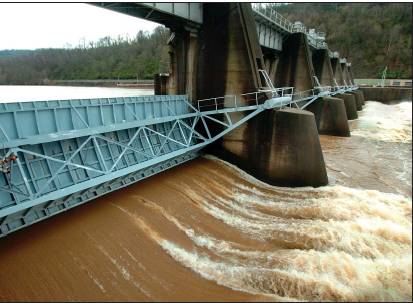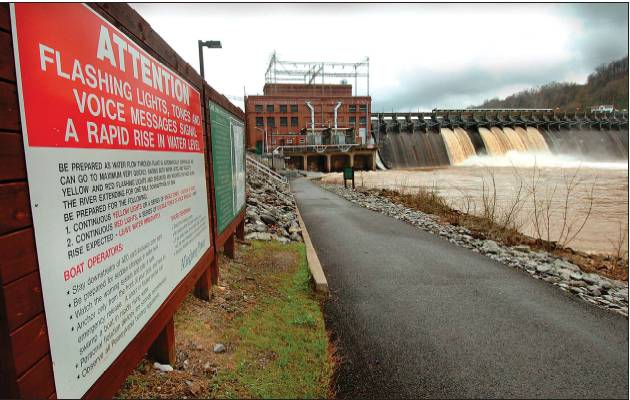
Morgantown Dominion Post
21 April 2007
By Evelyn Ryan

Bob Gay/The Dominion Post photos - Water rushes through the gates of the Morgantown Lock and Dam (left), a navigational structure on the Monongahela River in Morgantown. Monongalia, Preston and Marion counties have about 28 dams each, according to the National Inventory of Dams.
Say "dam" in Morgantown, and chances are you'll be told about the Morgantown Lock and Dam.
It's highly unlikely anyone will mention a second dam well within the city limits, an earthen structure built in 1956 known as the Cobun Creek Dam. The dam creates a small lake in White Park. That lake is the reservoir that supplies Morgantown with its water.
Cobun Creek is one of the dams that Delbert Shriver, an engineer with the state Department of Environmental Protection's environmental enforcement section, keeps his eye on.
Shriver is based in Fairmont. He and an assistant oversee about 250 dams in 25 northern West Virginia counties - including the Northern and Eastern Panhandles. But the threat of failure like the one Sunday in Lincoln County is rare, he said.
"We inspect as much as we can," he said, "with only two of us doing the inspections. We also have to inspect construction and modifications to any dam, review applications, review evacuation plans - we don't get down to routine inspections as much as we like to."
Heavy rains posed the threat of failure of an earthen dam in Lincoln County, forcing the evacuation of more than 700 people.
Monongalia, Preston and Marion counties have about 28 dams each, according to the National Inventory of Dams, kept by the U.S. Army Corps of Engineers, and Shriver's records.
Fortunately for Shriver, he has help. A number of the flood control dams in Upper Deckers Creek and Upper Buffalo Creek were installed by the old U.S. Soil Conservation Service. The current incarnation of the SCS, the National Resource Conservation Service, does annual inspection and maintenance of those structures, he said.
A number of the dams were built by coal companies to contain and process drainage from deep mines. Those are inspected by the DEP's coal section, he said.
The U.S. Army Corps of Engineers conducts an in-depth inspection on the major dams every five years. These are Tygart Lake and Stonewall Jackson, both flood control dams, and the Morgantown, Hildebrand and Opekiska locks and dams, all navigational structures.

Bob Gay/The Dominion Post photos - This view from the tailwaters of the Lake Lynn Hydro Station Dam, which creates Cheat Lake, shows the difference in level between Cheat Lake and the Cheat River.
Cheat Lake is created by Lake Lynn Dam, built by West Penn Power Co. (now part of Allegheny Energy) as a hydropower electric dam. Inspection and maintenance there is mandated by the Federal Energy Regulatory Commission, Shriver said.
But places like the Cobun Creek Dam, they're all Shriver's.
And Cobun Creek Dam, he said, is one of those in his region that doesn't have a certificate of compliance that it meets with state regulations.
This is news to Jim Green, general manager of the Morgantown Utility Board. MUB owns and maintains the dam, located on Cobun Creek behind University Motors.
"Those guys come up every year and we go over and inspect the dam," Green said. "Whatever they tell us to do, we do it. It's hard for me to imagine we are out of compliance."
Shriver said some damage to the spillway needs to be repaired.
Green explained that the spillway is carved out of solid rock and accumulates debris, which has to be cleared away. MUB crews are getting ready for the annual visit to clear the brush away and remove any trees that are growing out of the earthen dam.
MUB also has an emergency response plan should there be problems with the dam, he said.
But Cobun Creek isn't high on the DEP's list of dams to be concerned about, Shriver said. No one lives downstream. The creek winds by an old building with some small businesses before it goes into the water treatment plant.
About 10-15 dams in this region are on the "out-of-compliance" list, he said.
Two in Salem, Harrison County, are a source of concern because of housing developments below, and are being worked on right now, he said. The upper Salem Dam has been restored to compliance; the lower Salem Dam is under construction.
The next biggest concern, he said, would be the B&O Dam on Little Raccoon Creek at Newburg, Preston County. Built by the railroad in 1904, it supplied water for the steam engines running that region, and served as a water supply for the town.
The concern, he said, is mainly because of the age of the dam (102 years), deterioration of concrete and the spillway, which is not up to state standards.
Should that dam go, he said, the water would come right down through the town of Newburg.
"The majority of the dams in Monongalia, Preston and Marion counties we do have in compliance," Shriver said. "The ones we are most concerned about are in the Northern and Eastern Panhandles."
Many of the dams in this region are in rural or suburban areas, and away from heavily built sections of the county.
According to information on the Association of State Dam Safety Officials Web site, West Virginia regulates 359 dams out of the 555 statewide listed in the National Inventory of Dams.
Of that number, 267 are listed as having a high hazard potential should they break. Another 75 are listed as having a significant hazard potential while 17 are reported as having a low hazard potential.
Dams must meet specific criteria to be in the National Inventory of Dams. The categories are specified based on the potential damage downstream should one break.
High hazard potential means failure will probably cause loss of human life.
Significant hazard potential means failure results in no probable loss of human life but can cause economic loss, environment damage, disruption of lifeline facilities, or impact other concerns.
Low hazard potential means failure results in no probable loss of human life and low economic and/or environmental losses.